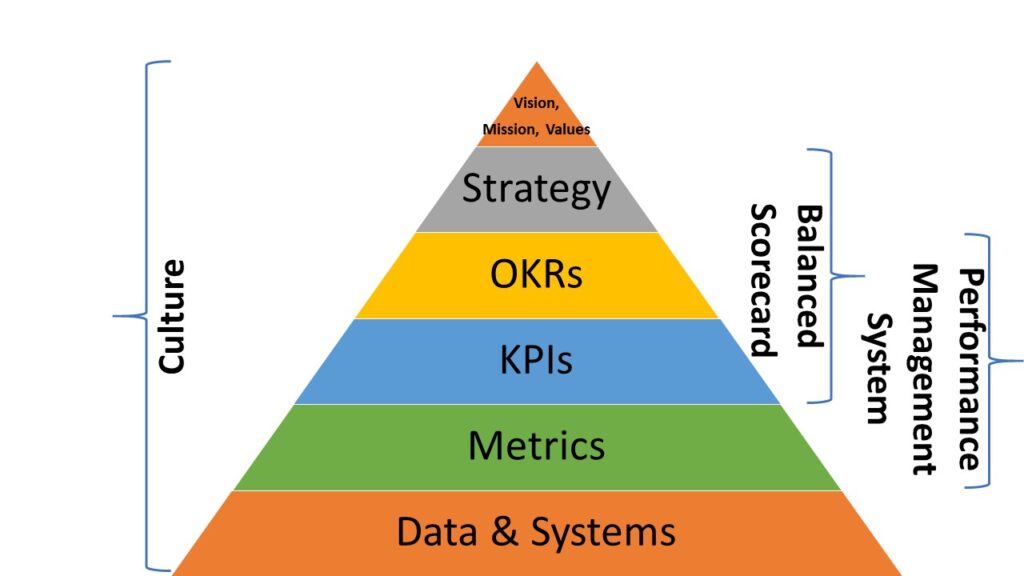
There has been a seemingly greater focus over the last decade, with businesses using data to make more informed decisions about their direction and purpose. I’ve been fortunate in my career that most of the companies I’ve worked with (and to be honest, most were larger organizations) already had fairly robust data collection processes and metrics in place. Over the past few years, I’ve come to see that this degree of measurement and value-add is still taking hold in many companies. The question has to be asked: What is the best way to make sense of, organize, and prioritize all that data to aid a company’s purpose?
If I picture a top-down approach, be it the iceberg analogy, the pyramid structure, or any ‘funnel’ diagram, I think we can safely agree where data’s involvement in a business starts and finishes. At the top of the pyramid is the strategy and direction. At the bottom of the pyramid are the raw data and the systems (ERPs, MRPs, HRMS, Financial, Customer, and others). How do they get linked to provide value, alignment, and insights?
Based on my experiences, there are three connecting layers.
The first is the company’s goals and OKRs (objectives and key results). Upon making strategic choices, an organization must develop the goals and objectives to implement the strategy. Once these are defined, measurements, usually called key results, must be created. These should be clear, well-defined outcomes (yes, or metrics) that will track an organization’s performance against its strategy. Often, some of these results will appear on a Balanced Scorecard (BSC). Some people believe a Balanced Scorecard should be created initially. Only afterwards, a strategy should be established (seemingly to improve BSC metrics that are trailing) for the company. I disagree with this approach. The long-term direction and decisions of an organization must come first. Successful CEOs view the landscape of change – be it internal, external (esp. customers), regulatory, competition, and/or technology to identify the company’s direction to continue to be relevant and grow. The four perspectives that are often shown in a Balanced Scorecard (customer, internal, learning and growth, and financial) regularly reflect the current state of a business. While they are all important, they are not always tied to the strategy. The strategic directions must be defined first to ensure the proper objectives (and outcomes) are identified and not vice versa (like having the proverbial cart leading the horse).
To give an example. A key result is directly linked to supporting a strategic direction and has very clear measurables (yes, think SMART). Say a manufacturing company has a strategic goal to have full automation (systems, robotics, AI) of its production lines in 5 years. A key result might be to invest $xM and have one line fully automated by the end of the year. This is a very specific outcome or achievable.
The next tier is the common one that many people in companies are already familiar with. To make OKRs (and even the strategy) more relatable to everyone, across divisions, departments, teams, and individuals, key performance indicators (KPIs) are introduced. In many cases, there can be overlaps between a key result and a KPI, though there is a subtle difference. I view a KPI more as supporting both the company’s and department’s key performance goals. In the example above, a KPI might be adherence to certain project timelines for the implementation. Or a KPI could be after the line is live, tracking the indicators of quality, productivity, and cost to support the investment. In both cases, again, think SMART. KPIs are that subset of metrics that an organization and the senior leadership believe are most relevant to the company’s success. Both the current state and supporting the strategy.
Finally, the last tier is what I would merely call metrics (or measurements). From the vast amounts of data that an organization collects, one needs to make it meaningful. Understanding what is relevant to an individual contributor, a department, or a division takes time and will change over the years, and yes, based in part on the strategy. A company needs to have robust systems to collect the data, interpret it, and summarize it into a meaningful representation that tells a story and shows trends. However, even with all these metrics, many should be given minimal attention. To be used only if a specific need arises. An organization can lose itself (yes, the paralysis by analysis analogy) by relying upon and tracking too many metrics. Have the ability to pivot quickly and adjust which metrics are your KPIs for a given year(s). Don’t get buried with tracking too many. Successful organizations keep a ‘critical few’ KPIs, usually < 10, to give a complete sounding board on their performance. More than this, and you will have competing measurements that won’t provide clear direction. Yes, keep it simple.
OKRs and KPIs are invaluable measurements to track a company’s current performance and alignment to its strategy. With their correct usage and deployment, most companies will have greater clarity on their successes and strengths, their obstacles and the countermeasures to overcome them, and how well they have strategic alignment.
Darren
